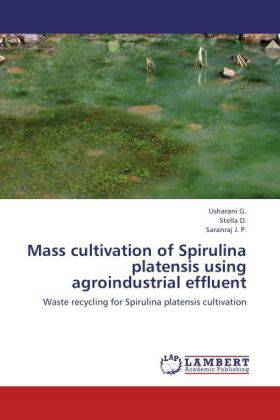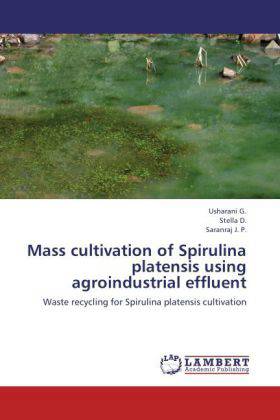
Je cadeautjes zeker op tijd in huis hebben voor de feestdagen? Kom langs in onze winkels en vind het perfecte geschenk!
- Afhalen na 1 uur in een winkel met voorraad
- Gratis thuislevering in België vanaf € 30
- Ruim aanbod met 7 miljoen producten
Je cadeautjes zeker op tijd in huis hebben voor de feestdagen? Kom langs in onze winkels en vind het perfecte geschenk!
- Afhalen na 1 uur in een winkel met voorraad
- Gratis thuislevering in België vanaf € 30
- Ruim aanbod met 7 miljoen producten
Zoeken
Mass cultivation of Spirulina platensis using agroindustrial effluent
Waste recycling for Spirulina platensis cultivation
G. Usharani, D. Stella, J. P. Saranraj
Paperback | Engels
€ 59,95
+ 119 punten
Omschrijving
The water samples were collected for the isolation of strains of alga Spirulina platensis from three different locations and the strain Spirulina platensis was isolated and it was, designated as ANS - 1 strain. The characteristics of Spirulina platensis ANS -1 were compared with reference CAS -10. The isolated strain ANS -1 and reference strain CAS 10 were grown in substrates 1/6 diluted Zarrouk s medium (control), Rice mill effluent and sago industrial effluent.The effect of temperature and pH was determined for the strains CAS - 10 and ANS -1, and highest biomass was observed at 30°C of pH 9.0. In this optimum condition the biomass observed in CAS -10 and ANS - 1 was found to be 0.42 and 0.38 g 100ml respectively. The growth of Spirulina platensis was measured both in laboratory and outdoor condition by using the parameters viz., optical density, population, dry weight, protein and chlorophyll content. The high growth was recorded in 1/6 diluted Zarrouk s medium followed by to rice mill effluent medium and sago industrial effluent. Maximum protein content was noticed in 1/6 diluted Zarrouk s medium followed by rice mill effluent and sago industrial effluent.
Specificaties
Betrokkenen
- Auteur(s):
- Uitgeverij:
Inhoud
- Aantal bladzijden:
- 92
- Taal:
- Engels
Eigenschappen
- Productcode (EAN):
- 9783659194597
- Verschijningsdatum:
- 30/07/2012
- Uitvoering:
- Paperback
- Afmetingen:
- 150 mm x 220 mm
- Gewicht:
- 139 g

Alleen bij Standaard Boekhandel
+ 119 punten op je klantenkaart van Standaard Boekhandel
Beoordelingen
We publiceren alleen reviews die voldoen aan de voorwaarden voor reviews. Bekijk onze voorwaarden voor reviews.









